Do you love animals? Have you ever been curious about how different species live together? If so, then this blog post is for you! I will explore the question of whether horses and cows can coexist peacefully in the same environment and graze together. From sharing resources to understanding behavior, we’ll uncover all the facts about this fascinating topic. Can you keep horses with cattle or should you keep horses separate?
- Introduction
- History of the Coexistence of Horses and Cattle
- Do Horses and Cows Get Along?
- Do Horses and Cows Fight?
- What Are the Pros of Grazing Horses and Cows Together?
- What Are the Cons of Grazing Horses and Cows Together?
- Summary Pros & Cons Keeping Horses and Cows Together
- Tips for Keeping Cows and Horses Together
- Fencing Options for Horses and Cows
- Feeding Horses and Cattle Living Together
- Making Sure They Get Along When Keeping Horses With Cattle
- Can Horses Get Sick From Cows and Vice Versa?
- Can Horses Get Worms From Cows?
- Conclusion
- Sources
Introduction
It is a common question whether horses and cows can live together peacefully. The answer is yes, horses and cows can and do live together in harmony. Horses and cows are both habitual grazers, so they make great companions. However, it is tricky to say how many cows and horses can be kept together as it depends largely on the available land and the number of horses. It is possible to pasture horses and cows together, as horses enjoy having some company even if it’s just one cow. It is important to be aware of flies as they can spread diseases between the two species. Additionally, it is important to properly introduce the two species to ensure they get along. Fencing options should also be considered when housing the two species together. Feeding should also be taken into consideration as horses and cattle eat differently. Lastly, it is essential to check for any diseases that can be passed between the two species such as bovine papillomavirus and equine sarcoids. With these tips in mind, cows and horses can live happily with one another.
History of the Coexistence of Horses and Cattle
Equids are generalist herbivores that coexist with cattle of similar body size in many groups of grazing herbivores in tropical ecosystems of Africa. In temperate ecosystems during the Holocene, wild horses (Equus species) appear to have overlapped extensively with steppe-dwelling bison species and woodland wild cattle. In 15,000- to 17,000-year-old cave paintings, horses are seen together with aurochs, which is a sign that horses have lived around the predecessors of our livestock for a very long time.

Photo: Lascaux, Public domain, via Wikimedia Commons
Do Horses and Cows Get Along?
Yes, horses and cows can and do live happily together. Both animals are habitual grazers, so they make great companions. Horses enjoy having some company, and cows are better than no company. Although not many studies have been conducted, it is possible that horses can have their social needs met by contact with other species. Goodwin (1999) has described that horses usually prefer to socialize with those of their kind but can accept other species as a company if necessary. You should never keep a lonely horse. Furthermore, domesticated horses are adapted to form relationships with other species and can understand their body language.
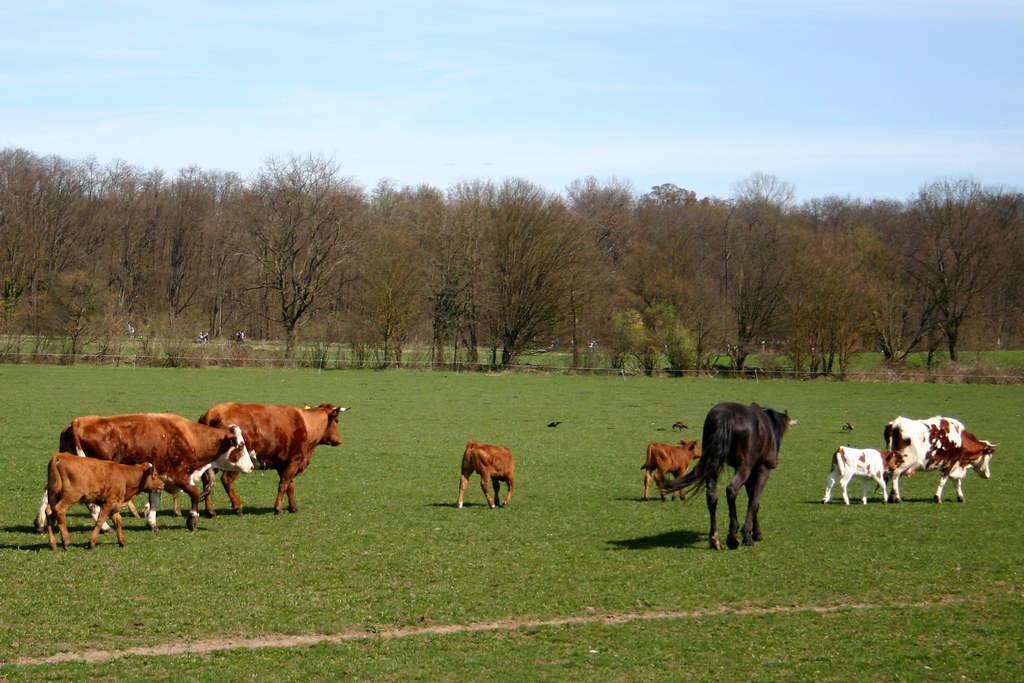
Photo: “Cows and horses II” by tillwe is licensed under CC BY-SA 2.0.
However, there are some things to be aware of when grazing horses and cattle together. It is important to be mindful of cattle with horns as they can do some major damage to a horse’s body. Finally, it is important to consider the different ways horses and cattle eat pasture to ensure that both animals have access to the nutrition they need and that it does not become too crowded. With the right precautions and good management, many horses get along well with cows.

Do Horses and Cows Fight?
Although horses and cows can live together harmoniously, they do occasionally fight. Horses (more commonly stallions) can be territorial and become aggressive if they feel their space is threatened. It is possible horses will chase the cows. It is important to ensure that each animal has enough space and food to roam to avoid altercations.
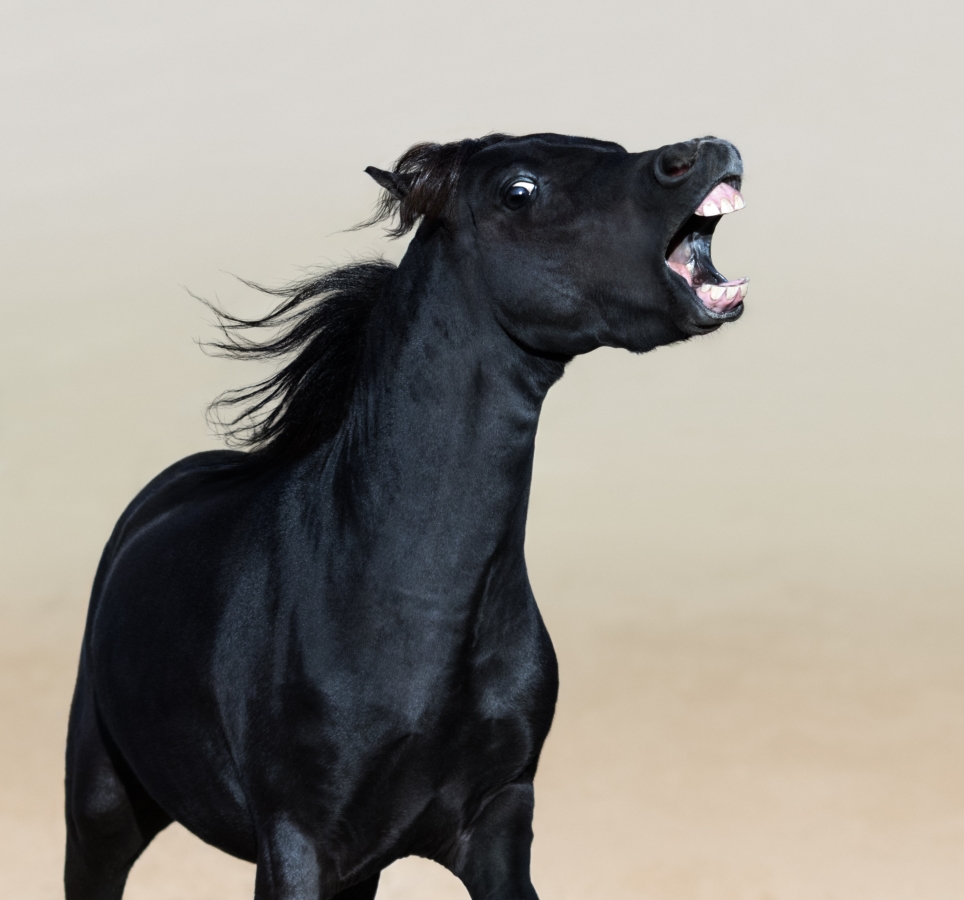
If any fighting does occur, it is important to separate the animals so that no one gets hurt or seriously injured. With the right environment, attention, and management, horses and cows can live together peacefully. Keeping horses around cows with horns can be a risk. Be sure that cows with horns are horse safe before they are brought together.
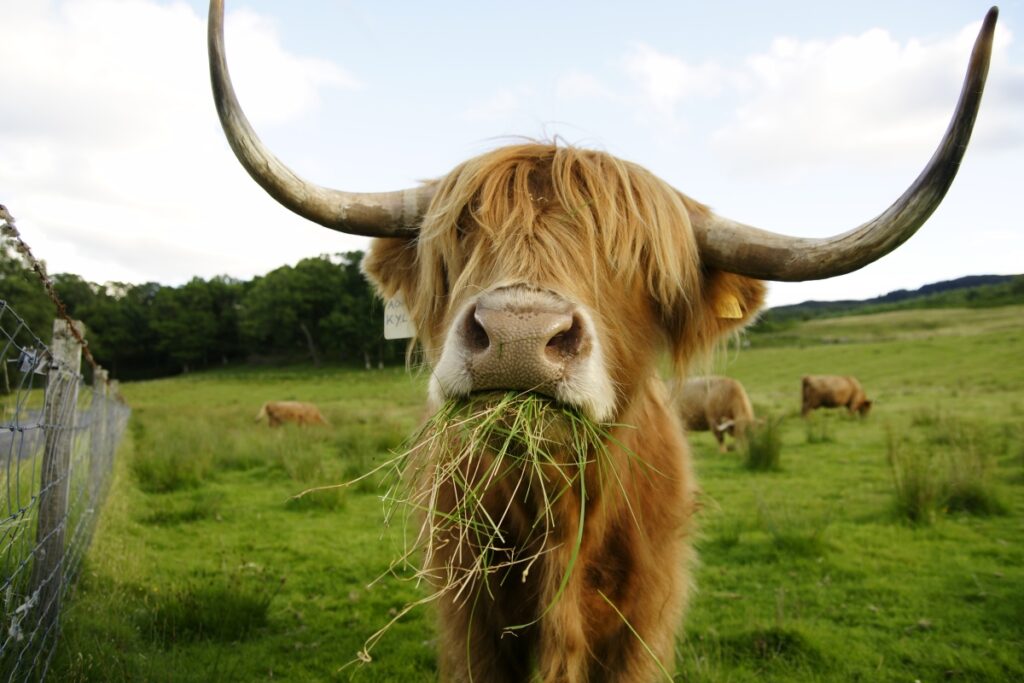
What Are the Pros of Grazing Horses and Cows Together?
Worm Control
Grazing horses and cows together have several benefits. The biggest one is the control of worm populations in horses. Cattle are not susceptible to the same nematode worms horses are, so having them in the same pasture can help reduce the worm population in horses and cattle. In addition, feeding a mixed species can be more beneficial for both animals as they can access better nutrition that is not available to either species alone. If they have the opportunity horses will avoid eating where they have droppings. As the cows graze and eat the grass in these places, they will “vacuum” up the horses’ parasites which will not survive and can reproduce in the cow. In this way, better use is made of the pasture and the parasites are fewer.

Photo: “File:Strongylus vulgaris.jpg” by Froggerlaura at English Wikipedia is licensed under CC BY-SA 3.0.
Better Nutrition With Mixed Species Grazing
Grazing horses and cows together can be beneficial for both species in terms of nutrition. Studies have shown that grazing horses and cattle together can reduce the burden of strongyles in young horses, while also reducing the residual biomass and enhancing the feeding value of the grazed forage. As previously mentioned, cross-grazing benefits include better nutrition, as more forage will be used than if the animals were kept apart.

Furthermore, since cows and horses eat pasture differently, they can complement one another’s grazing habits, helping to make sure that all available forage is eaten. Finally, since cows tend to graze on taller vegetation than horses, this can help prevent horses from consuming too much lush grass. Horses tend to graze close to the ground with their incisor teeth. Horses have incisors in both their upper and lower jaws. Cows only have the lower incisors and only the gum in the front of the upper jaw and they use their tongue to rip the grass off. Therefore, mixed grazing with cattle can be beneficial for both species in terms of nutrition.
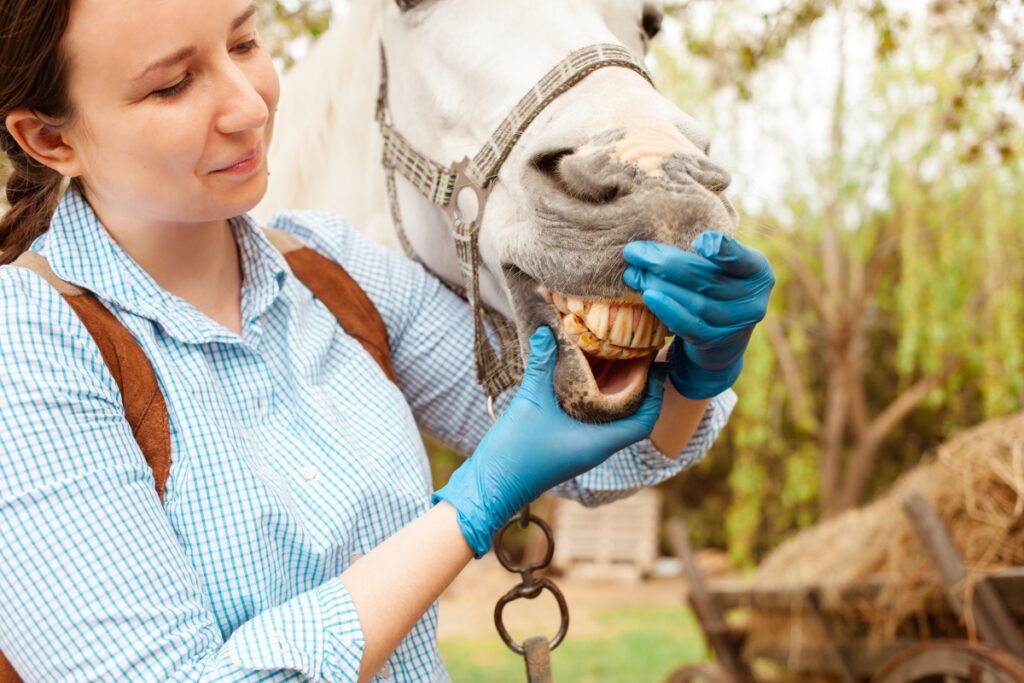
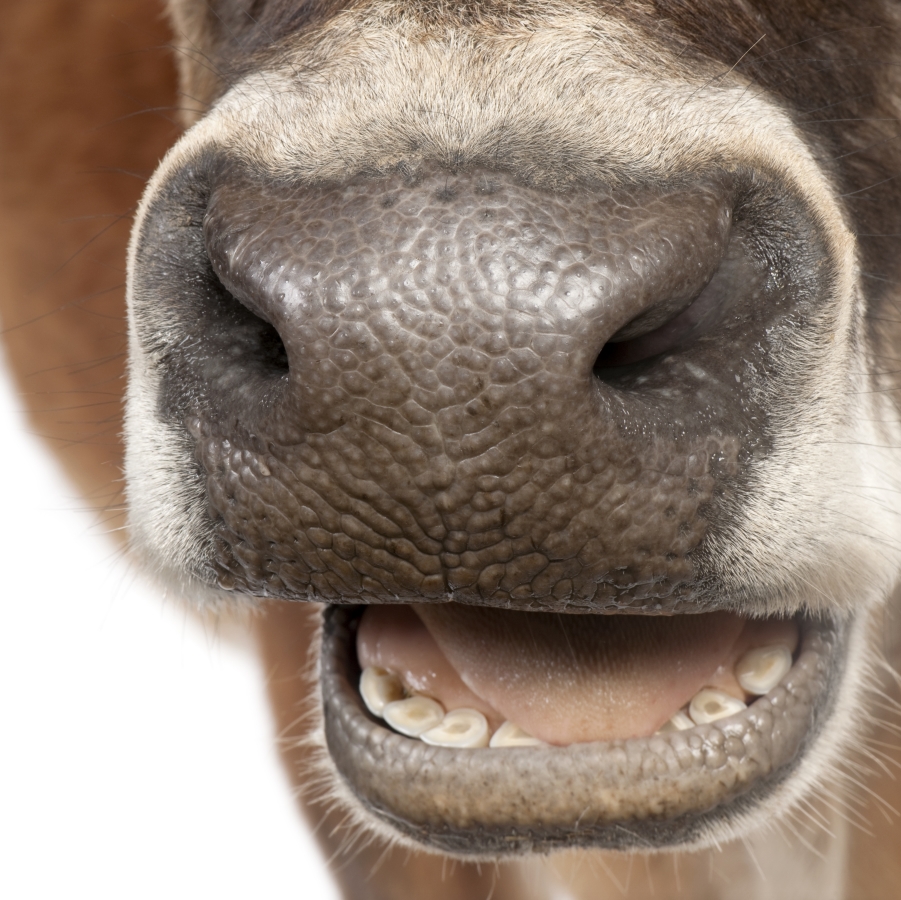
Enhanced Biodiversity
As horses and cows graze differently, this will benefit biodiversity. Equids are generalist herbivores that coexist in many ecosystems with bovids of comparable body sizes.
As domestic horses and cattle are often used in Europe to maintain nature reserves, especially wetlands, it is crucial to have a comprehensive understanding of their foraging behavior and comparative diet. A French study describes how horses and cattle use resources in two French wetlands. Horses used marshes heavily during the warmer seasons; both species used grasslands throughout the year; cattle used herbs and shrubs more than horses. The niche width was similar and the overlap was high. Horses spent more time grazing short grass than cattle.

Horses are an excellent tool for plant management because they remove more vegetation per unit of body weight than cattle. They also consume more of the most productive plant communities and species (especially graminoids). In addition, they graze closer to the ground and maintain a mosaic of patches of short and tall grass, which contributes significantly to structural diversity. On the other hand, cattle consume more broadleaf plants than horses. They can also reduce the rate of encroachment by certain woody species.
What Are the Cons of Grazing Horses and Cows Together?
Although grazing cows and horses together can have plenty of benefits, there are a few drawbacks to consider as well.
- Horses and cows need different types of nutrition, so if the pasture is not managed carefully, it can cause nutritional deficiencies for one or both animals. It’s important to keep an eye on both horses and cattle when they are in the same pasture and make sure they are healthy and getting adequate nutrition.
- If they don’t get along, they can hurt each other.
- Some diseases can be spread between horses and cows.
Summary Pros & Cons Keeping Horses and Cows Together
- Reduces worm burden in both spieces
- Better use of pasture land
- Enhanced biodiversity
- Different nutritional needs
- Spread of diseases
- Risk of injury if they fight
Tips for Keeping Cows and Horses Together
It is important to ensure they get along when it comes to keeping horses and cattle together. Some basic tips can help ensure that the two species coexist peacefully. Firstly, it is important to check the fencing. Horses and cows vary in size and strength, so it’s important to make sure that the fencing can contain both species and prevent them from escaping or fighting. Secondly, it is best to ensure their diet is tailored to each species.

Cattle and horses eat pasture differently, so it is important to provide the right type of hay for each and enough of it. Lastly, make sure they have access to clean water and plenty of space so they can graze comfortably. With the right management, horses and cattle can live together happily and provide great companion grazing.
Fencing Options for Horses and Cows
When it comes to fencing, it is important to consider the needs of both horses and cows. For cows, barbed wire is a common option since it can keep them in and no need for electricity. Barbed-wire is completely unsuitable for horses. Horses, unlike cows, will panic if they get caught in the fence and will tear themselves free. This usually results in nasty injuries, sometimes so serious that the horse has to be put down.
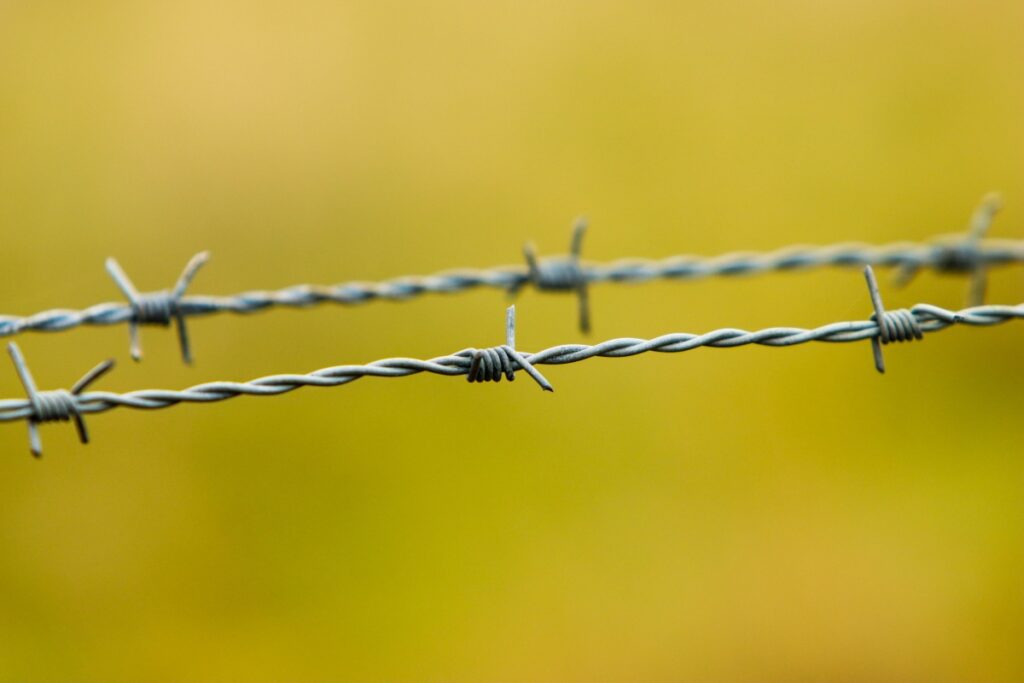
However, for horses, electric fencing is often used. Electric fences are usually used for horses. Electric fencing is safe for horses as it does not usually cause injury if used correctly. It is important that electric fencing is properly stretched and that the tension in the wire is high enough. An electric fence with high voltage can also protect from predators. Electric fences also work well for cows, which is why this is a good option if the animals will be grazing together. Another option is wooden fencing, which is also considered safe for both species. Complemented with electric wire, it is even safer.

When installing a fence for both animals, it is important to pay attention to the local regulations regarding materials, sizes, and colors. Additionally, it is important to use materials that are strong enough so the animals will not be able to push on them with ease. Finally, it is important to make sure the fence is high enough so the animals cannot jump over it or reach through it.
Feeding Horses and Cattle Living Together
When feeding horses and cattle together, it’s important to keep in mind the differences between the two species. They have very different digestive systems although they are both grazers. Unlike ruminants, equines have two sets of incisors, which may allow them to feed more quickly on shorter grass than cattle. It’s important to provide hay for both animals when not enough grass is provided.

High-quality hay or haylage is a great source of nutrition for both species and can help satisfy their cravings for fiber. Cattle and horses can also benefit from being given minerals, vitamins, and other supplements to supplement their diets. They might also need grain mix depending on age and breed. Both species need a supplement of salt. Finally, it’s important to keep monensin out of cow feed, as it is lethal to horses. By taking these steps, horse and cattle owners can ensure their animals get the nutrition they need while living together in harmony.
Comparison of Feed Intake in Horses and Cows
A study from 2002 was the first to measure comparative daily forage intake. Results showed that horses consumed 63% more than cattle. Although the digestibility of the cattle diet was slightly higher, the daily intake of digestible dry matter (i.e., nutrient extraction) was significantly higher in horses than in cattle. When forage is scarce, horses are more successful than cattle in grassland habitats because their functional response is steeper; under these circumstances, cattle need an ecological refuge to survive the winter, such as in an area with many trees or shrubs.
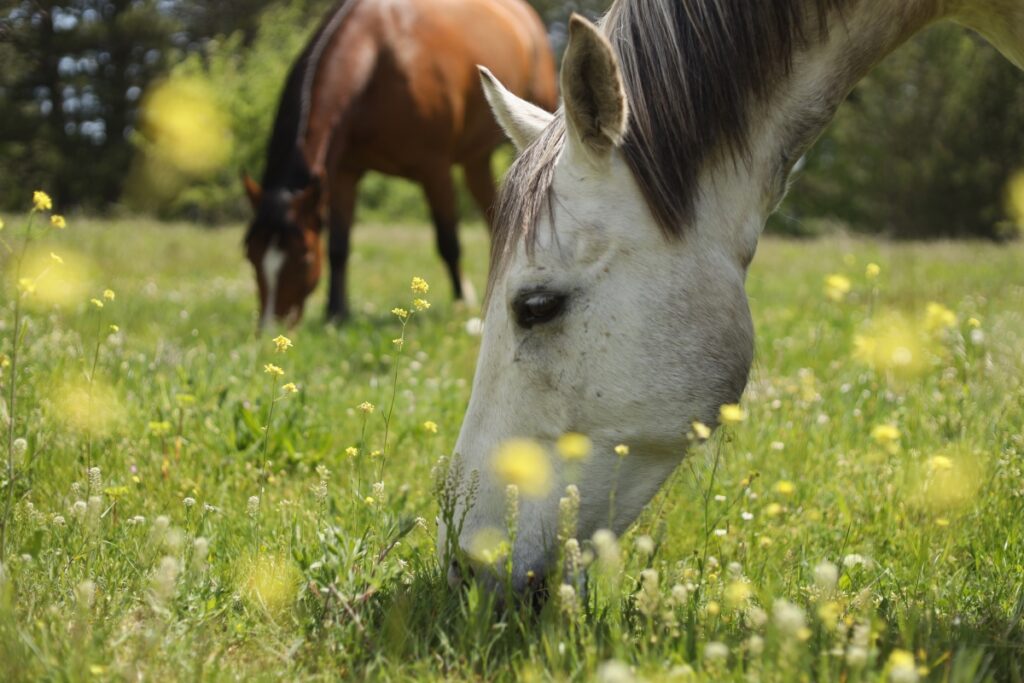
Monensin (Monensin Sodium)
Monensin is an antibiotic made from polyether that is isolated from Streptomyces cinnamonensis. It is frequently used in cattle feed. However, ingestion of monensin can be deadly for dogs, horses, and other equids, as well as guinea fowls, as sensitivity to monensin varies greatly between different animal species. For example, horses are approximately 20 times more sensitive than cattle. Common symptoms of ionophore poisoning in dogs or horses are cardiomyopathy, neurological and muscular problems, vomiting, and sudden death.

The main risk is that horses could get access to vomit or regurgitated stomach contents of cow food. However, there is no risk from excreting the substance in feces because the concentrations that could be dangerous for these animal species are not reached. As a safety measure, these categories of animals must be kept away from the medicine and not stay in areas where treated cattle have been.
Botulism
Hay silage and silage are different feeds used for both horses and cows. These feeds may contain the botulinum toxin. Both species are sensitive to this toxin and may die from ingestion. It is important to maintain the good hygienic quality of the feed and not to feed bales containing dead animals or soil.
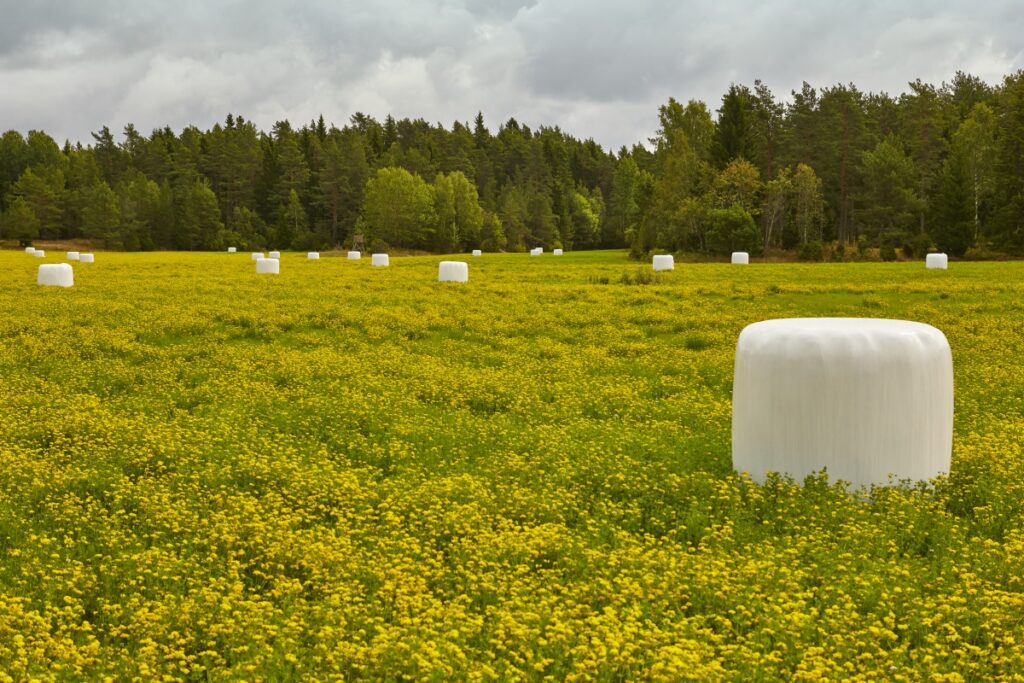
Making Sure They Get Along When Keeping Horses With Cattle
It is important to ensure the safety and well-being of both horses and cattle when living together. To do this, it is best to introduce them slowly and carefully. Start by letting them get used to each other’s smell first, before allowing them to be in the same area together. You should also provide plenty of space for them to move around in, as well as lots of food options so that they can graze together without getting too close to one another. It’s also important to watch out for signs of aggression from either animal and take action if necessary. Finally, by understanding these risks and taking the appropriate steps, you can make sure that your horses and cows live happily together.
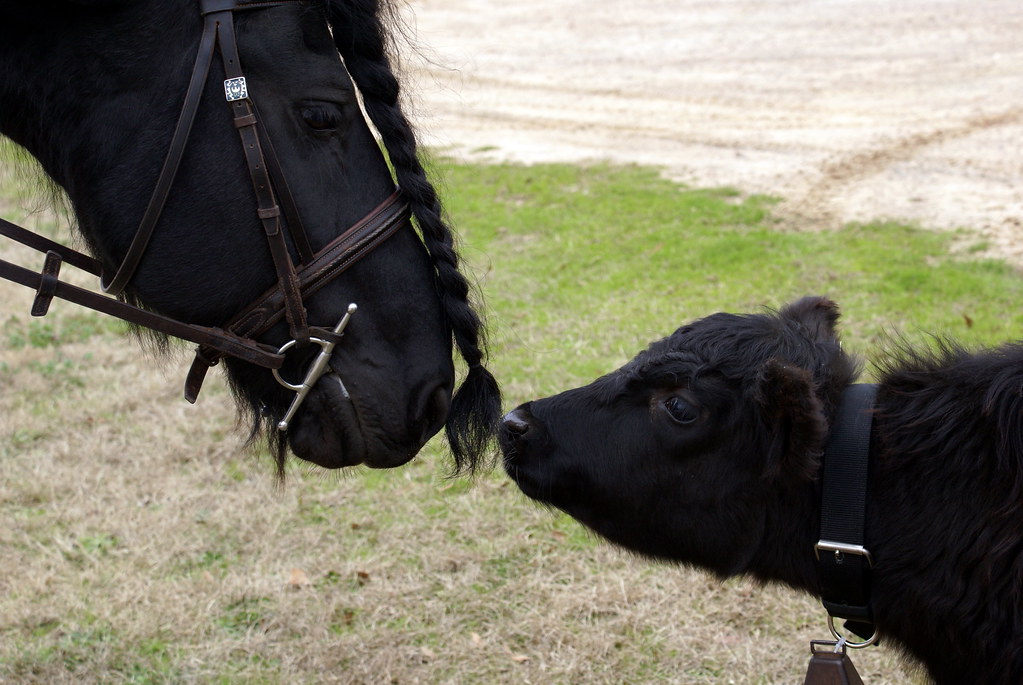
Photo: “Horse and Cow Kiss” by Clevergrrl is licensed under CC BY-SA 2.0.
Can Horses Get Sick From Cows and Vice Versa?
Yes, several diseases can be spread between animal species. Some of these diseases are serious.
Vesicular stomatitis in horses and cows
Vesicular stomatitis is a virus that affects horses, cattle, pigs, sheep, goats, and llamas. It is transmitted through direct contact with infected animals or by blood-feeding insects such as black flies or sand flies. Symptoms include excessive drooling and ulcers or erosions of the mouth linings, tongue, and lips. Lameness may also occur due to foot ulcers. Although there is no specific treatment, infected animals should be isolated, and softened feeds should be provided to prevent general ill health and malnutrition. To reduce the risk of exposure to the virus, owners should limit pasture time and provide shelters or barns during insect feeding times. Vaccines are available in some Latin American countries but none are available in the US. This disease is reportable in most areas due to its similar symptoms to other diseases such as foot-and-mouth disease in cattle and swine.
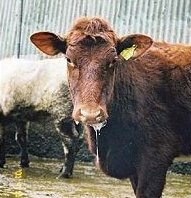
Photo: Official Nebraska Goverment Website, Public domain, via Wikimedia Commons
Foot-and-mouth Disease in Cows and Horses
Foot-and-mouth disease is a highly contagious virus that affects cattle and horses as well as other species. It is found in parts of Asia, Africa, the Middle East, and South America and can spread quickly through direct contact between animals, as well as through contaminated tools, clothing, and transport vehicles. Symptoms in cattle include fever, loss of appetite and milk production, blisters in the mouth and on the feet and hooves, excessive salivation, and lameness. Pigs may also show fever, reduced appetite, and lameness. Symptoms in sheep and goats are less clear and often limited to lameness. Diagnosis involves a physical examination to identify blisters, as well as virus testing of bladder contents, bladder wall, and/or blood samples. If the foot-and-mouth disease is suspected, it is important to call a veterinarian immediately, bring in all animals from the same herd and close off the facility until a veterinarian takes over the case.
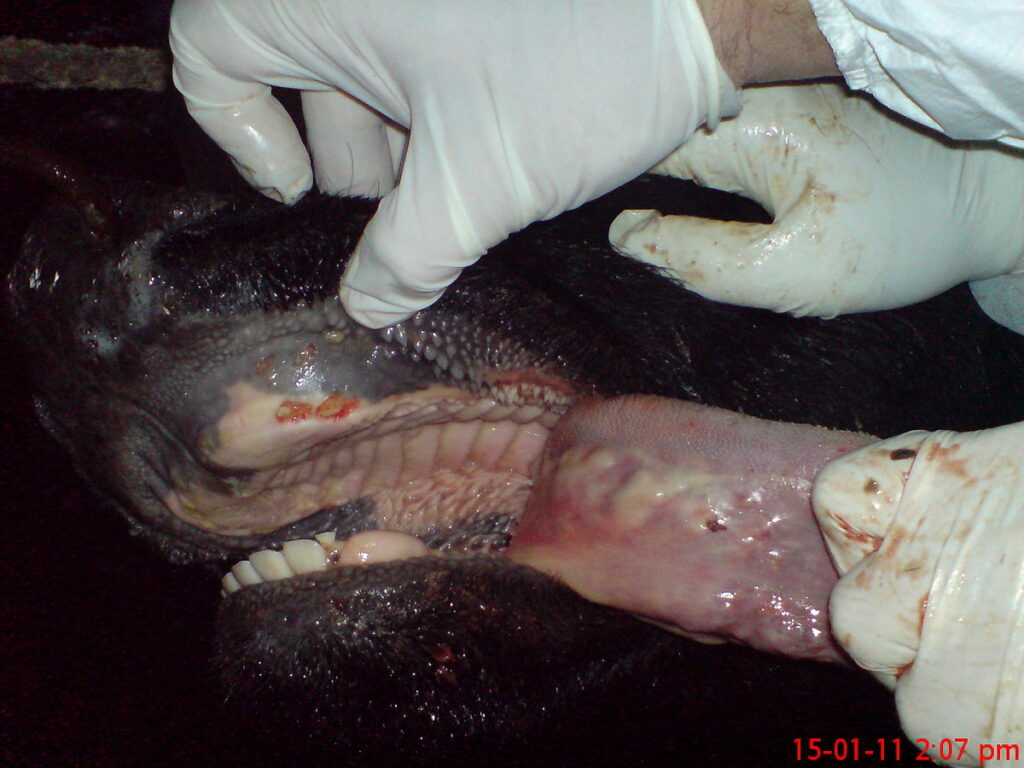
Photo: dr. D. Denev, CC BY-SA 3.0 https://creativecommons.org/licenses/by-sa/3.0, via Wikimedia Commons
Ringworm
Ringworm is a fungal infection of the skin or hair that is common in horses and cattle. Humans can also be infected by ringworm. It is caused by a type of fungus called Trichophyton equinum, Trichophyton mentagrophytes, and Trichophyton verrucosum. The infection is spread by contact with infected individuals or contaminated objects such as grooming tools. Symptoms include circular, bald, scaly patches with broken hairs in areas such as the girth, saddle, neck, flanks, chest, and head. Ringworm can be diagnosed by fungal culture or direct microscopic examination. Treatment with medicated shampoos can help speed recovery. If you suspect your horse or cattle may have ringworm, contact your veterinarian for advice on how to treat the infection and what precautions to take to avoid getting it or spreading it to others.
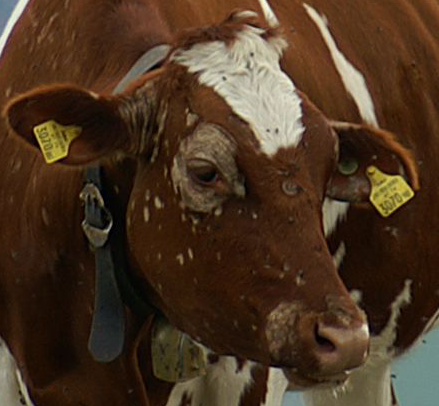
Photo: AyrshireCattle2.JPG: böhringer friedrichderivative work: Pitke, CC BY-SA 2.5 https://creativecommons.org/licenses/by-sa/2.5, via Wikimedia Commons
Bovine Papillomavirus and Equine Sarcoids
Research has found that there is a correlation between a form of bovine papillomavirus (BPV) and equine sarcoids. Investigations have identified strains of BPV other than types 1 and 2, which have been typically associated with sarcoids in equids. It is believed that BPV type 1 can infect both cattle and horses, leading to the pathogenesis of sarcoids. This means that, while it may be possible for a cow virus to cause tumors in horses, it is also important to take precautions when keeping horses and cows together. The virus can be spread by horn flies and other types of flies.
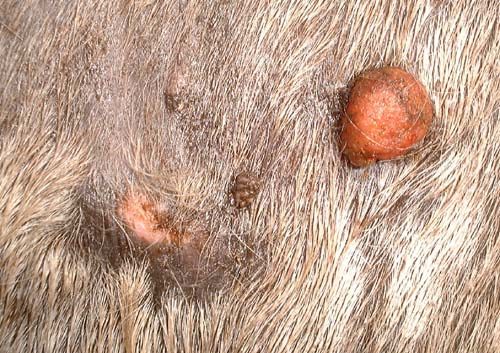
Photo: “Equine sarcoid sarkoid u konia 1” by User:Malcolm_Morley is licensed under CC BY-SA 3.0.
Can Horses Get Worms From Cows?
Horses and cows can share grazing land, with some benefits to both species. However, one of the questions that often arises is whether horses can get worms from cows. Research conducted by a French team has provided evidence that mixed grazing with cattle helps control strongyle worms in horses. This is because cattle don’t support the same nematode worms as horses, meaning that the risk of transmission of worms from cows to horses is non-existent.
Conclusion
In conclusion, horses and cows can live together peacefully if the right conditions are met. It is important to keep an eye on the animals to make sure they are getting along and to take appropriate measures to prevent health risks, such as fencing and separating them when necessary. Mixed grazing can also be beneficial for both species, providing them with better nutrition and helping to control strongyle worms in horses. With proper planning, pasture management, and care, horses and cows can be great companions that coexist happily together.
Sources
Comparative foraging and nutrition of horses and cattle in European wetlands
Catherine Menard, Patrick Duncan, Geraldine Fleurance, Jean-Yves Georges, Marc Lila
First published: 26 June 2002 https://doi.org/10.1046/j.1365-2664.2002.00693.x
Epidemiological Aspects of Dermatophyte Infections in Horses and Cattle
A. Moretti, L. Boncio, P. Pasquali, D. Piergili Fioretti
First published: 13 May 2010 https://doi.org/10.1111/j.1439-0450.1998.tb00784.x
Goodwin, D. 1999. The importance of ethology in understanding the bebehaviorf
the horse. Equine Veterinary Journal. 31, 15-19.

